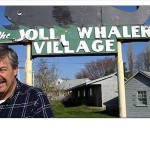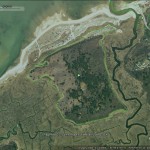
It was another blustery spring day on Cape Cod when I decided to see what was doing out on Wing Island. The first sign that something was up was the hip boots stacked neatly at each end of the trail across the marsh behind the Museum of Natural History. They were the emergency boots for getting across at high tide. I imagined work crew supervisor Vince Ollivier hiding them from his Americorps team to strand them on the island until all the work was done.
And what a job they have done! Former Brewster conservation administrator Seth Wilkinson is a young man on a mission to cure the Cape of its invasive species ills and restore flourishing historical landscapes. His plan to recreate 10 acres on the west side of Wing Island to its former glory as pastureland was taking shape under Americorps’ young hands.

As the team stacked brush they had cut into enormous piles for burning, Vince finished explaining the meadow restoration to a dozen volunteers from the Museum, so they could in turn explain it to visitors this summer. The clearing has opened up the west flank of Wings Island to the edge of Quivett Marsh, creating a panorama from the bay to the Old Kings Highway. Raptors such as hawks and owls can now have free rein over the field and marsh. The team has opened up not just a view, but an imagination. We can muse about John Wing and his family doing the same thing on the island 300 years ago, minus the snarl of the chain saw.
I stood there and catalogued all of the exciting environmental doings within a half-mile of Wings Island. That day, the backhoes were finishing the scraping of the Jolly Whaler site on Rt. 6A, where the Brewster Conservation Trust and Town are designing a simple but elegant park. Less is certainly more there. The trailers are gone from the marshside parcel and the herring were running up Stony Brook behind it. The Museum itself had placed 68 of its acres under a permanent conservation restriction last year with the BCT.
Looking westwards up Quivett Creek, I thought about the Town of Dennis and its partnership with Brewster and the State to install a redesigned culvert under the old Sea Street Dike to improve herring and tidal flow to the upper reaches of the creek: another eco-restoration success story. And that led me to Dennis’ spectacular success at Crowes Pasture. In another week, Dennis Town Meeting would approve the most recent open space acquisition, the 4.5-acre missing link parcel along the marsh. Dennis has purchased 66 conservation acres at Crowes in the past three years for $7.15 million, of which half has come from state, federal and private contributions. The meadow restoration at Crowes Pasture, 12 acres cleared now with nesting bluebirds taking note, is the bookend to the Wings Island clearing across the marsh.
The partnership among the town governments and land trusts in Brewster and Dennis to preserve the Quivett Marsh watershed has been an achievement worth “crowe-ing” about. Though perhaps by happenstance rather than intent, the cumulative total of these individual actions should make any observer of the Cape’s environmental scene feel refreshed. While there is legitimate cause for doom and gloom in what is happening to our Cape Cod, a Wing Island hiker on a spring day could put it out of his mind for an hour. And relish the thought that we need not accept the hand we are dealt. Occasionally, with vision and effort, we can reshuffle the deck.
Mark H. Robinson
Executive Director
The Compact of Cape Cod Conservation Trusts, Inc.
May 2005

